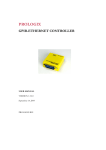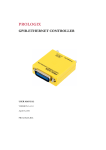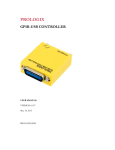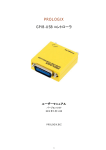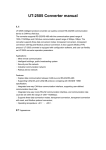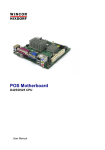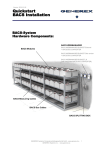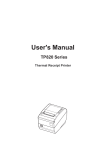Download User`s Manual - Sewell Direct
Transcript
PROLOGIX GPIB-LAN CONTROLLER USER MANUAL VERSION 1.0 August 5, 2008 PROLOGIX.BIZ Prologix GPIB-LAN Controller User Manual Table of Contents 1. 2. 3. 4. 5. 6. Introduction ..........................................................................................................................4 Installation.............................................................................................................................4 Firmware Upgrade ...............................................................................................................4 Host Software .......................................................................................................................4 Configuration........................................................................................................................5 Operating Modes..................................................................................................................5 6.1. Controller Mode..........................................................................................................5 6.2. Device Mode................................................................................................................6 7. Data Transmission ...............................................................................................................6 8. Commands ............................................................................................................................7 8.1. addr................................................................................................................................7 8.2. auto................................................................................................................................7 8.3. clr...................................................................................................................................9 8.4. eoi ..................................................................................................................................9 8.5. eos..................................................................................................................................9 8.6. eot_enable ..................................................................................................................10 8.7. eot_char ......................................................................................................................10 8.8. ifc .................................................................................................................................10 8.9. loc ................................................................................................................................10 8.10. mode ...........................................................................................................................11 8.11. read..............................................................................................................................11 8.12. read_tmo_ms .............................................................................................................12 8.13. rst.................................................................................................................................12 8.14. spoll .............................................................................................................................12 8.15. srq ................................................................................................................................12 8.16. trg.................................................................................................................................13 8.17. ver................................................................................................................................13 8.18. help..............................................................................................................................13 9. Specifications ......................................................................................................................13 8/5/2008 2 Prologix GPIB-LAN Controller User Manual Change Log Aug 5, 2008 8/5/2008 Initial version. 3 Prologix GPIB-LAN Controller User Manual 1. Introduction Prologix GPIB-LAN controller converts any computer with a nerwork port into a GPIB Controller or Device. In Controller mode, Prologix GPIB-LAN controller can remotely control GPIB enabled instruments such as Oscilloscopes, Logic Analyzers, and Spectrum Analyzers. In Device mode, Prologix GPIB-LAN controller converts the computer into a GPIB peripheral for downloading data and screen plots from the instrument front panel. In both modes, Prologix GPIB-LAN controller interprets high level commands received from the host computer and performs the appropriate low-level GPIB protocol handshaking. 2. Installation Connect Prologix GPIB-LAN controller to any network enabled computer using an Ethernet cable. No special drivers are required. The type of cable to use depends on the computer. If the computer supports auto-MDIX, which almost all newer ones do, use a straight Ethernet cable. If the computer does not support auto-MDIX, use a cross-over Ethernet cable. If a cross-over Ethernet cable is not available connect both Prologix GPIB-LAN controller and computer to a network hub (or switch). 3. Firmware Upgrade Prologix GPIB-LAN controller firmware is field upgradeable. Latest firmware and upgrade installations are available at prologix.biz 4. Host Software A wide variety of host software may be used to communicate with Prologix GPIB-LAN controller: Terminal programs – any terminal emulation program such as HyperTerminal, Tera Term Pro, or Minicom can be used to communicate with the controller and instruments connected to it. Custom applications – any programming language or environment that provides network access may be used to develop custom applications. Graphical programming environments like National Instruments LabView and Agilent VEE may be used as well. EZGPIB – an easy to use, programming environment developed by Ulrich Bangert for developing data acquisition applications. Web link to this tool can be found at prologix.biz. 8/5/2008 4 Prologix GPIB-LAN Controller User Manual Plotter emulators – plotter emulation applications such as 7470.exe can be used to obtain screen plots from GPIB enabled instruments using Prologix GPIB-LAN controller. Details on how to configure these tools are available at prologix.biz. 5. Network Configuration Prologix GPIB-LAN controller supports static IP address and dynamic (DHCP) IP address. The controller’s network parameters can be configured using the NetFinder.exe tool available at prologix.biz. 6. GPIB Configuration GPIB parameters of Prologix GPIB-LAN controller can be configured using any of the following methods: Prologix.exe – Prologix.exe is an open source tool developed by John Miles for configuring the controller. Web link to the tool can be found at prologix.biz. Terminal program – any terminal emulation program such as HyperTerminal, Tera Term Pro, or Minicom can be used to configure the controller by manually entering appropriate commands (See Commands). Using the terminal program open a TCP connection to port 1234 at Prologix GPIB-LAN controller’s IP address. You may want to enable the “Local Echo” feature in the terminal program to view the commands being entered. Please consult the FAQ at prologix.biz, or the program’s user manual, for detailed configuration steps for various terminal programs. Prologix GPIB-LAN Controller stores the latest configuration settings in non-volatile memory. These settings are not address specific. If you have multiple instruments on the GPIB bus that require different configuration settings, you must change the settings before communicating with each instrument. 7. Operating Modes Prologix GPIB-LAN controller can operate in two modes – CONTROLLER and DEVICE. You can switch between the two modes using ++mode command (see Commands). 7.1. Controller Mode In Controller mode, the GPIB-LAN Controller acts as the Controller-In-Charge (CIC) on the GPIB bus. When the controller receives a command over the network port terminated by the network terminator – CR (ASCII 13) or LF (ASCII 10) – it addresses the GPIB instrument at the currently specified address (See ++addr command) to listen, and passes along the received data. 8/5/2008 5 Prologix GPIB-LAN Controller User Manual When Read-After-Write feature is enabled (See ++auto command) Prologix GPIB-LAN Controller will addresses the instrument to talk after sending a command, in order to read its response. All data received from instruments over GPIB is sent to host over the network. Read-After-Write feature simplifies communication with instruments. You send commands and read responses without consideration for low level GPIB protocol details. When Read-After-Write feature is not enabled Prologix GPIB-LAN controller does not automatically address the instrument to talk. You must use the ++read command to read data. Controller mode is used to remotely control instruments and to download screen plots by sending plot commands from a host computer. 7.2. Device Mode In Device mode, Prologix GPIB-LAN Controller acts as another peripheral on the GPIB bus. In this mode, the controller can act as a GPIB TALKER or GPIB LISTENER only. Since Prologix GPIB-LAN Controller is not the Controller-In-Charge while in this mode, it expects to receive commands from a GPIB controller. When Device mode is enabled Prologix GPIB-LAN controller configures itself as a GPIB Listener. All data received by the controller over the GPIB port is passed along to the network port without buffering. All data received from the host over the network is buffered until the GPIB controller addresses Prologix GPIB-LAN controller to talk, at which time the buffered data is passed along to the GPIB port. The controller can buffer only one command. A subsequent command received over the network will overwrite the previously buffered one, if the previous one has not yet been transmitted over GPIB. Device mode is used to download screen plots from the instrument front panel for rendering using plotter emulation software. 8. Data Transmission In Controller and Device modes, characters received over the network port are aggregated in an internal buffer and interpreted when the network termination character – CR (ASCII 13) or LF (ASCII 10) – is received, or when the internal buffer1 becomes full. CR, LF, and ESC (ASCII 27) characters must be escaped by preceding them with an ESC character if they are part of the network data. All un-escaped LF, CR and ESC characters in network data are discarded. As mentioned earlier, an un-escaped CR or LF acts as the network terminator. The terminating CR or LF is removed and GPIB termination characters (specified by ++eos command) are appended before transmitting 1 Internal buffer is 512 bytes but is subject to change in future versions. 8/5/2008 6 Prologix GPIB-LAN Controller User Manual data to instruments. Any network input that starts with the “++” character sequence is interpreted as a controller command and not transmitted over GPIB. When configured to do so – using the ++auto command or the ++read command – characters received from instruments are transmitted to host. Unlike while sending data to instruments, no character substitution is performed.. The ++eot_char command may be used to detect GPIB EOI signal assertion. 9. Commands Prologix GPIB-LAN controller provides several commands to configure its behavior. They are explained in detail in the following sections. All commands start with the “++” character sequence. 9.1. addr The addr command is used to configure, or query the GPIB address. Meaning of the GPIB address depends on the operating mode of the controller. In CONTROLLER mode, it refers to the GPIB address of the instrument being controlled. In DEVICE mode, it is the address of the GPIB peripheral that Prologix GPIB-LAN controller is emulating. If the command is issued with no parameters, the currently configured address is returned. SYNTAX: ++addr [<address>] where address is a decimal value between 0 and 30. MODES AVAILABLE: CONTROLLER, DEVICE EXAMPLES: ++addr 5 ++addr – Set GPIB address to 5 – Query current GPIB address NOTE: Default GPIB address of many HP-GL/2 plotters is 5. 9.2. auto Prologix GPIB-LAN controller can be configured to automatically address instruments to talk after sending them a command in order to read their response. The feature called, Read-After-Write, saves the user from having to issue read commands repeatedly. This command enabled or disabled the Read-After-Write feature. 8/5/2008 7 Prologix GPIB-LAN Controller User Manual In addition, auto command also addresses the instrument at the currently specified address to TALK or LISTEN. ++auto 0 addresses the instrument to LISTEN and ++auto 1 addresses the instrument to TALK. If the command is issued without any arguments it returns the current state of the readafter-write feature. SYNTAX: ++auto [0|1] MODES AVAILABLE: CONTROLLER NOTE: Some instruments generate “Query Unterminated” or “-420” error if they are addressed to talk after sending a command that does not generate a response (often called nonquery commands). In effect the instrument is saying, I have been asked to talk but I have nothing to say. The error is often benign and may be ignored. Otherwise, turn off readafter-write feature before issuing non-query commands. Later turn on the feature after issuing query commands to read response. For example: ++auto 0 SET VOLT 1.0 *idn? ++auto 1 "HP54201A" — — — — — Turn off read-after-write and address instrument to listen Non-query command Query command Turn on read-after-write and address instrument to talk Response from instrument Or, use the ++read command to read the instrument response. For example: ++auto 0 SET VOLT 1.0 *idn? ++read eoi "HP54201A" 8/5/2008 — — — — — Turn off read-after-write and address instrument to listen Non-query command Query command Read until EOI asserted by instrument Response from instrument 8 Prologix GPIB-LAN Controller 9.3. User Manual clr This command sends the Selected Device Clear (SDC) message to the currently specified GPIB address. Please consult the programming manual for details on how a particular instrument responds to this message. SYNTAX: ++clr MODES AVAILABLE: CONTROLLER 9.4. eoi This command enables or disables the assertion of the EOI signal with the last character of any command sent over GPIB port. Some instruments require EOI signal to be asserted in order to properly detect the end of a command. SYNTAX: ++eoi [0|1] MODES AVAILABLE: CONTROLLER EXAMPLES: ++eoi 1 ++eoi 0 ++eoi 9.5. Enable EOI assertion with last character Disable EOI assertion Query if EOI assertion is enabled or disabled eos This command specifies GPIB termination characters. When data from host is received over the network, all non-escaped LF, CR and ESC characters are removed and GPIB terminators, as specified by this command, are appended before sending the data to instruments. This command does not affect data from instruments received over GPIB port. If the command is issued with no arguments then the current configuration is returned. SYNTAX: ++eos [0|1|2|3] where: 0 – CR+LF, 1 – CR, 2 – LF, 3 – None MODES AVAILABLE: CONTROLLER EXAMPLES: ++eos 0 ++eos 1 ++eos 2 ++eos 3 ++eos 8/5/2008 Append CR+LF to instrument commands Append CR to instrument commands Append LF to instrument commands Do not append anything to instrument commands Query current EOS state 9 Prologix GPIB-LAN Controller 9.6. User Manual eot_enable This command enables or disables the appending of a user specified character (see eot_char) to network output whenever EOI is detected while reading a character from the GPIB port. If the command is issued without any argument, the current state of eot_enable is returned. SYNTAX: eot_enable [0|1] MODES AVAILABLE: CONTROLLER EXAMPLES: ++eot_enable 1 ++eot_enable 0 ++eot_enable 9.7. Append user defined character when EOI detected Do not append character when EOI detected Query current eot_enable state eot_char This command specifies the character to be appended to network output when eot_enable is set to 1 and EOI is detected. If the command is issued without any argument, the currently specified character is returned. SYNTAX: eot_char [<char>] where <char> is a decimal value less than 256 MODES AVAILABLE: CONTROLLER EXAMPLES: ++eot_char 42 ++eot_char 9.8. Append * (ASCII 42) when EOI is detected Query currently configured eot_char ifc This command asserts GPIB IFC signal for 150 microseconds making Prologix GPIBLAN controller the Controller-In-Charge on the GPIB bus. SYNTAX: ++ifc MODES AVAILABLE: CONTROLER 9.9. loc This command enables front panel operation of the currently addressed instrument. 8/5/2008 10 Prologix GPIB-LAN Controller User Manual SYNTAX: ++loc MODES AVAILABLE: CONTROLLER 9.10. mode This command configures the Prologix GPIB-LAN controller to be a CONTROLLER or DEVICE. If the command is issued without any arguments, the current mode is returned. SYNTAX: ++mode [0|1] where 1 – CONTROLLER, 0 – DEVICE MODES AVAILABLE: CONTROLLER, DEVICE EXAMPLES: ++mode 1 ++mode 0 ++mode 9.11. Switch to CONTROLLER mode Switch to DEVICE mode Query current mode read This command can be used to read data from an instrument until: • EOI is detected or timeout expires, or • A specified character is read or timeout expires, or • Timeout expires Timeout is set using the read_tmo_ms command and applies to inter-character delay, i.e., the delay since the last character was read. Timeout is not be confused with the total time for which data is read. SYNTAX: ++read [eoi|<char>] where <char> is a decimal value less than 256 MODES AVAILABLE: CONTROLLER EXAMPLES: ++read ++read eoi ++read 10 8/5/2008 Read until timeout Read until EOI detected or timeout Read until LF (ASCII 10) is received or timeout 11 Prologix GPIB-LAN Controller User Manual 9.12. read_tmo_ms This command specifies the timeout value, in milliseconds, to be used in the read command and spoll command. Timeout may be set to any value between 1 and 4000 milliseconds. SYNTAX: ++read_tmo_ms <time> where <time> is decimal value between 1 and 4000 MODES AVAILABLE: CONTROLLER 9.13. rst This command performs a power-on reset of the controller. The process takes about 5 seconds. All input received over the network during this time are ignored. SYNTAX: ++rst MODES AVAILABLE: CONTROLLER 9.14. spoll This command performs a serial poll of the instrument at the specified address. If no address is specified then this command serial polls the currently addressed instrument (as set by a previous ++addr command). This command uses the same time-out value specified by the read_tmo_ms command. SYNTAX: ++spoll [<address>] where address is a decimal value between 0 and 30 MODES AVAILABLE: CONTROLLER EXAMPLE: ++spoll 5 ++spoll Serial poll instrument at GPIB address 5 Serial poll currently addressed instrument 9.15. srq This command returns the current state of the GPIB SRQ signal. The command returns ‘1’ is SRQ signal is asserted (low) and ‘0’ if the signal is not asserted (high). SYNTAX: ++srq MODES AVAILABLE: CONTROLLER 8/5/2008 12 Prologix GPIB-LAN Controller User Manual 9.16. trg This command issues Group Execute Trigger GPIB command to devices at the specified adresses. Upto 14 addresses maybe specified. Addresses must be separated by spaces. If no address is specified then Group Execute Trigger command is issued to the currently addressed instrument (as set by a previous ++addr command). Refer to the programming manual for a specific instrument’s response to Group Execute Trigger command. SYNTAX: ++trg [<address1> <address2> … <address14>] MODES AVAILABLE: CONTROLLER 9.17. ver This command returns the version string of the Prologix GPIB-LAN controller. SYNTAX: ++ver MODES AVAILABLE: CONTROLLER, DEVICE 9.18. help This command prints a brief summary of all available commands. SYNTAX: ++help MODES AVAILABLE: CONTROLLER, DEVICE 10.Specifications Dimensions: 3.25 in. (L) x 2.5 in. (W) x 1.0 in. (H) Weight: 2 oz. GPIB commands not supported: PARALLEL POLL, PASS CONTROL Power: 8-15V DC, 200 mA Indicators: Power IP configuration: Static and Dynamic (DHCP) TCP port: 1234 8/5/2008 13














